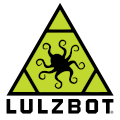
Open HardwareAssembly Instructions
Guides for installation and assembly of the LulzBot line of products made by FAME 3D LLC.

Guides for installation and assembly of the LulzBot line of products made by FAME 3D LLC.
Load and print the gcode file called Dual_Extruder_E-steps_Calibration.gcode.
On your Graphical LCD controller or through Pronterface set each hot end to your desired extrusion temperature (ABS: 230, PLA: 180). Allow the printer to come up to temperature.
Print the Dual_Extruder_E-Step_Calibration.gcode file to extrude out 100mm of filament from each extruder.
Measure the distance between the top of the extruder and the 100mm marking to check the calibration. If the extruder overshot the 100mm mark, measure the distance to the 110mm mark and subtract that reading from 110mm.
Once you have the amount for filament being fed by each extruder during the extrusion test, calculate the new extruder e-step value using:
New_Value = 100*(Old_Value/Measured_Extrusion)
If the extruder overshot the 100mm mark, measure the distance to the 110mm mark and subtract that measurement from 110mm.
Using the LCD screen, navigate to:
For KITTAZ and TAZ 1 users, you will need to reflash your firmware. (If no LCD upgrade has been done)
KITTAZ users flashing guide can be found here
TAZ 1 users flashing guide can be found here
Perform the previous steps again to verify that the extruders have been calibrated correctly. When calibrated correctly, your 100mm mark will be right on top of the extruder. If not, perform the calibration process again.
Once the calibration has been confirmed, proceed to the next step.
Now that the extruders are calibrated, you are going to need to level them to each other and the print bed.
Adjust the Z axis end stop to increase distance between bed and hot ends. (Prevents damage to your glass bed)
Home all axis through Pronterface or LCD screen
Adjust Z axis end stop, and re-home until the rear extruder is at a distance of two paper widths from the glass bed
Position front extruder to same location that rear extruder measurements were taken in previous step.
* Adjust the thumb screw on the front of the dual extruder until paper resistance is equal to rear extruder
Check both extruder heights at all four corners by repeating the previous steps.
Open Slic3r
Download the Slic3r Dual Extruder Configuration (You may need to right click, and save link as to download.)
FlexyDually users will need to download the Slic3r FlexyDually Extruder Configuration
Load the Dual Extruder Configuration into Slic3r
Change the second extruder settings from Default > Dual Extruder Slic3r Config 2x0.35mm Nozzle
Download the Calibration Squares.amf.xml
Add the Calibration Squares.amf into Slic3r
Press Export Gcode and select desired location to save the file
Load the Gcode file into Pronterface or on to your SD card
Set temperatures from your LCD or Pronterface
Once your printer is heated to temperature, print the Gcode file
Using Calipers or the Ruler, measure how far off the sqaures are from being centered on one another.
Measure the gap between the two squares on the left, rigth, top and bottom sides.
To determine the offset, plug the measured values into the table found here:
In Cura, under Machine Settings > Extruder 2.
Update the Extruder Offset positions, with the values you found in the previous step.
Save your configuration by selecting OK.
Re-Slice and print the Calibration Squares using the updated extruder offset.
Measure the top, bottom, left, and right gaps between the two squares to verify equal distance
If the gaps are not even, return to "Measure Current Offset"
If the gaps are even, Congratulations your dual extruder is calibrated!